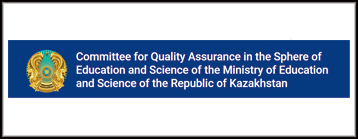Gold and rare earth elements in enrichment products from the technogenic wastes of the Caspian Mining-Metallurgical Plant (Aktau, Kazakhstan)
DOI:
https://doi.org/10.31643/2024/6445.09Keywords:
gold, REEs, micro- and nano-sized grains, technogenic wastes, Caspian Mining-Metallurgical Plant, Kazakhstan.Abstract
The paper presents the outcome of a comprehensive study at macro- to nanoscale levels of enrichment products from technogenic wastes. The products were obtained thanks to the experience of gravity enrichment during the treatment and preparation of the gold and REE sample material with preliminary mechanical and thermal activation. Thermal activation was applied for the first time. Native gold was identified in the form of single, micron-sized grains and, according to technological testing of enrichment products, there is a predominance of "invisible" dispersed gold. The gold content in the initial material was 2.93 g/t, which upon thermal activation of the sample increased to 6.37 g/t. According to the spectral analysis and electron probe microanalysis, the products of all enrichment stages are characterized by an increased content of yttrium and REEs. The REEs occurrence forms were determined. REEs are mainly found in micro- and nano-sized fluorine and fluorine-free phosphates (in apatite, by substitution of calcium), in REE-phosphates (in xenotime), and less often, possibly, in complex sulfo-phosphates and phosphate silicates. In thermal products consisting of inhomogeneous aggregates of nanosized phases, according to X-ray phase analysis, considering the elemental composition, REEs are included in the composition of phosphates: florensite and phases Ce(P5O14), Ca8MgSm(PO4)7.
Downloads
References
Nesterov YuV, Petrukhin NP. Sozdaniye i razvitiye mineralno-syryevoy bazy otechestvennoy atomnoy otrasli [Creation and development of the mineral resource base of the domestic nuclear industry].Under the general editorship PetrukhinaNP. Moscow: JSC Atomredmetzoloto.2017,400. (in Russ.).
Shushakov MT, Isakov GM. O Prikaspiyskom gorno-metallurgicheskom kombinate (informatsionnaya zapiska) [About the Caspian Mining and Metallurgical Combine (information note)].2013.(In Russ.).
Nesterov YV, Petrukhin N P. Syryevaya baza atomnoy promyshlennosti. Sobytiya. lyudi. Dostizheniya [Raw Material Base of Nuclear Industry. Events, people, achievements]ed. by N.P. Petrukhin.Moscow.2015, 286.(in Russ.).
Amdur AM, Vatolin NA, Pavlov VV. et al. Content of impurities in dispersed ore gold particles depending on their size.Doklady Physical Chemistry.2016; 470(2):162-164. https://doi.org/10.1134/S0012501616100067
Damchev VI, Strelyanov NP. Ekzogennyye mestorozhdeniya urana [Exogenous Uranium Deposits}. Moscow, Atomizdat.1979, 248.(in Russ.).
Laverov NP, Shumilin MV, Melnikov IV, Luchin IA. Spravochnik geologa po poiskam i razvedke mestorozhdeniy urana [Handbook of geologist on prospecting and exploration of uranium deposits]. Moscow, Nedra.1989, 270.(in Russ.).
Pirmatov EA, Pirmatov AE, Shafranov AG, Turko SI. Perspektivy razvitiya proizvodstva redkozemelnykh metallov v Respublike Kazakhstan [Prospects of development of production of rare-earth metals in the Republic of Kazakhstan]. Materialy nauchnoy konferentsii «Kanysh Satbayev–velikiy uchenyy. organizator. geniy. patriot» [Materials of the scientific conference "Kanysh Satbayev, great scientist, organizer, genius, patriot"]. JV Sareco LLP, Stepnogorsk.2017.(in Russ.).
Pozin ME. Tekhnologiya mineralnykhudobreniy [Technology of mineral fertilisers]. Leningrad, Chemistry.1989, 352.(in Russ.).
Solodov NA, Semenov EI, Burkov VV. Geologicheskiy spravochnik po tyazhelym metallam [Geological Handbook on Heavy Metals]. Edited by N.P. Laverov. Moscow, Nedra.1987, 438.(in Russ.).
Pat. 7613KZ. Termoaktivator [Thermo-activator]. Bekenova GK. Publ. 25.11.2022.NIIS MoJ bull.47(in Russ.).
Surkov AV, Akhapkin AA. Problema izvlecheniya melkogo i tonkogo zolota pri osvoyenii rossypey i tekhnogennykh otvalov [The problem of fine and fine gold extraction during development of placers and technogenic dumps}. Tsvetnye Metally= Non-ferrous metals2003; 1:13-16.(in Russ.).
Baturin GNN, Asavin AM, Kolesov GM. Noble metals in recentand ancient phosphorites.Dokl. Earth Sc. 2006; 407:408-411. https://doi.org/10.1134/S1028334X06030147
Baturin GN, Dubinchuk VT. Forms of gold and platinum in phosphorites on the Namibian Shelf. Dokl. Earth Sc. 2006; 407:233-235. https://doi.org/10.1134/S1028334X06020176
Mikhailik P,Mikhailik E,Ivanov V. Gold in Ferromanganese Deposits from the NW Pacific. Minerals.2021; 11:979. https://doi.org/10.3390/min11090979
Felitsyn SB, Alfimova NA. Gold in biogenic apatites of the Baltic-Ladoga phosphate-bearing basin.Zapiski Gornogo Institut. 2022; 255:470-475. https://doi.org/10.31897/PMI.2022.47
Shkolnik EL, Abdel MV. Zoloto i serebro v mezo-kaynozoyskikh fosforitakh Severnoy Afriki [Gold and silver in Meso-Cenozoic phosphorites of North Africa].Uralskiy Geologicheskiy Zhurnal = Ural Geological Journal 2012; 5:14-22.(in Russ.).
Berikbolov BR, Petrov NN, Karelin VG. Handbook. Spravochnik. Mestorozhdeniya urana Kazakhstana [Uranium Deposits of Kazakhstan]. Institute of Geological Sciences KISatbayev, RGP PCV, Almaty, 2015, 244.(in Russ.).
Votsalevsky ES, Zhukov NM, Kiselev AL, et al. Minerageniya mezozoy-kaynozoy Kazakhstana [Mesozoic-Cenozoic minerageny of Kazakhstan].Almaty.2012, 402.(in Russ.).
Spravochnik. Basseyny i mestorozhdeniya gorno-khimicheskogo syria Kazakhstana[Handbook. Basins and Deposits of Mining and Chemical Raw Materials of Kazakhstan], 2nd ed. Almaty.2015, 293. (in Russ.).
KenzhaliyevBK,Surkova TY,Berkinbayeva AN.To the question of the intensification of the processes of uranium extraction from refractory raw materials. Metalurgija. 2019; 58(1-2):75-78.
Kenzhaliev BK, Surkova TYu, Berkinbayeva AN, Dosymbayeva ZD, Chukmanova MT. To the question of recovery of uranium from raw materials. News of the National Academy of Sciences of the Republic of Kazakhstan: Series of geology and technical sciences. 2019; 1(433):112-119. https://doi.org/10.32014/2019.2518-170X.14
Miroshnichenko LA, Tilepov ZT.Spravochnik. Mestorozhdeniya zheleza Kazakhstana [Handbook. Iron Deposits of Kazakhstan]. Institute of Geological Sciences KI Satbayev, RGP PCV, 2nd ed. Almaty.2016, 258.(in Russ.).
Spravochnik. Mestorozhdeniya gornorudnogo syria Kazakhstana [Handbook. Deposits of mining raw materials in Kazakhstan], 2nd ed. Almaty.2016, 409.(in Russ.).
Peregudov VV, Shautenov MR, Bukreev VF, Levin VL, Kotelnikov PE. Osobennosti stroyeniya glaukonita na mestorozhdeniyakh Seletinskoye i Izobilnoye (Severnyy Kazakhstan) [Structural features ofglauconite at the Seletinskoye and Izobilnoye deposits (Northern Kazakhstan)]. Resursovosproizvodyashchiye,malootkhodnyye i prirodookhrannyye tekhnologii osvoyeniya nedr. Materialy XV Mezhdunarodnoy konferentsii,v ramkakh simpoziuma «Vosstanovleniye natsionalnoy ekonomiki Sirii» [Resource-reproducing, low-waste and environmental technologies for subsoil development. Materials of the XV International Conference, within the framework of the symposium "Restoration of the national economy of Syria"]. Syria, Homs -Russia, Moscow. September 12-17.2016, 274-277.(in Russ.).
Peregudov VV, Shautenov MR. Krupnoye Celetytenizskoye mestorozhdeniye glaukonita [Large Seletteniz glauconite deposit].Nauchnyye osnovy i praktika pererabotki rud i tekhnogennogo Syria [Scientific bases and practice of processing ores and technogenicraw materials}. 2018, 187-192.(in Russ.).
Downloads
Published
How to Cite
Issue
Section
License
Copyright (c) 2023 Bekenova, G., Peregudov, V., Levin, V., Kanatbaev, Y., & Muratkhanov, D.

This work is licensed under a Creative Commons Attribution-NonCommercial-NoDerivatives 3.0 Unported License.


























